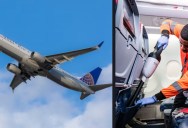Learn About How Airplanes Are Really Cleaned
by Matthew Gilligan
How and when do people clean airplanes? Who does it, and how often? Is it safe to travel? If you’re curious, we’ve got answers to those questions below.
First off, infectious disease expert Sanjaya Senanayake says,
“The risk of getting a communicable disease on a plane is quite low … not zero, but very low.
The reason it is so hard to get infected by a sick passenger on a plane has to mostly do with the plane’s circulation system and advanced filters in many parts of the world and they are good enough to filter virus.”
In addition to these built-in features, most companies use a special anti-microbial spray that they apply to walls, seats, television screens, armrests, and tray tables once a plane is done for the night.
Sarah Adam, General Manager of Product and Customer Experience for Virgin Australia, says the product they use also protects against many viruses.
“The product is called DuroPax.
The beauty of the product, is it allows us to protect our guests and customers from many strains of viruses including influenza.
It is environmentally safe and non-toxic so everyone can rest assured when they jump on board they are safe.”
The product has been tested, with germ readings before and after applications, and the results are more than acceptable – cleaner than your cell phone would be right now if someone swabbed it, probably.
That said, the cleaning procedures are only applied at the end of each day, so if you’re flying anything other than the first flight of the day, you’ll want to take your own extra precautions – wash your hands with soap and water, use hand sanitizer between washings, take Clorox wipes to wipe down your own tray table, television, armrests, et al.

Sign up to get our BEST stories of the week straight to your inbox.





